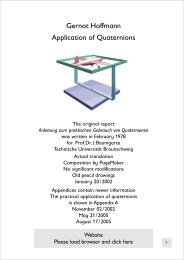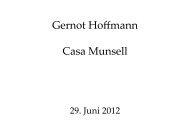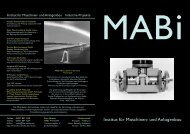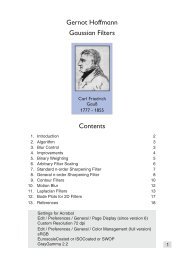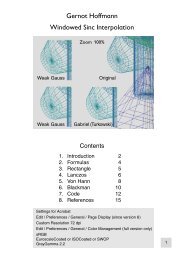Newton's Prism Experiment and Goethe's Objections
Newton's Prism Experiment and Goethe's Objections
Newton's Prism Experiment and Goethe's Objections
You also want an ePaper? Increase the reach of your titles
YUMPU automatically turns print PDFs into web optimized ePapers that Google loves.
Gernot Hoffmann<br />
Newton’s <strong>Prism</strong> <strong>Experiment</strong><br />
<strong>and</strong> Goethe’s <strong>Objections</strong><br />
Contents<br />
1. Introduction 2<br />
2. Snell’s law <strong>and</strong> Sellmeier’s equation 6<br />
3. Calculations for the ray path 7<br />
4. Geometry for maximal dispersion 8<br />
5. Ray visualization <strong>and</strong> a photo 9<br />
6. Gamut limitation for sRGB 10<br />
7. Gamut compression 11<br />
8. Mapping the rays 12<br />
9. Single ray / RGB clipping 13<br />
10. Single ray / CIELab compression 14<br />
11. Single ray / Linear spectrum 15<br />
12. Multiple ray / Illuminant Equal Energy 16<br />
13. Multiple ray / Illuminants A,D50,D65,D75 17<br />
14. Goethe’s explanations 18<br />
15. Conclusions 19<br />
16. Hoffmann’s prism experiment 20<br />
17. Reverse problem <strong>and</strong> inverse appearance 21<br />
18. References 22<br />
1
1.1 Introduction / How to use this doc<br />
This document can be read by Adobe Acrobat. Some settings are essential: the color space<br />
sRGB for the appearance; the resolution 72dpi for pixel synchronized images.<br />
Best view zoom 200% (title image <strong>and</strong> photo on p.20).<br />
Settings for Acrobat<br />
Edit / Preferences / General / Page Display (since version 6)<br />
Custom Resolution 72dpi<br />
Edit / Preferences / General / Color Management (full version only)<br />
sRGB<br />
Euroscale Coated or ISO Coated or SWOP<br />
Gray Gamma 2.2<br />
A reasonable reproduction of the colors is possible only by a calibrated cathode ray tube<br />
monitor or a high end LCD monitor (no hope for notebooks or laptops).<br />
The monitor should be calibrated or adjusted by these test patterns:<br />
CalTutor<br />
http://www.fho-emden.de/~hoffmann/caltutor270900.pdf<br />
Printing this doc accurately requires a calibrated printer, preferably an inkjet or high end color<br />
laser printer. Office printers cannot reproduce the spectrum bars reasonably.<br />
Accurate printing requires a calibrated printer<br />
This document is protected by copyright. Any reproduction requires a permission by the author.<br />
This should be considered as a protection against bad or wrong copying. The author provides<br />
on dem<strong>and</strong> files in RGB for the specific purpose in original quality <strong>and</strong> files for CMYK offset<br />
printing (which cannot reproduce sRGB colors correctly), adjusted as good as possible.<br />
Copyright<br />
Gernot Hoffmann<br />
August 2005<br />
2
1.2 Introduction / About Newton<br />
Isaac Newton lived from 1642 to 1727. His work about optics <strong>and</strong> color was probably inspired<br />
by Descartes, Charleton, Boyle <strong>and</strong> Hook [5]. Refraction <strong>and</strong> dispersion by prisms were already<br />
known at this time, but Newton introduced 1666 a set of three crucial experiments (in fact by<br />
numerous experiments):<br />
1. Refraction <strong>and</strong> dispersion of a thin ray, which produces a spectrum b<strong>and</strong> with all rainbow<br />
colors: red, orange, yellow, green, blue, indigo <strong>and</strong> violet.<br />
2. Condensation of the spectrum b<strong>and</strong> by a lens. This delivers again white light.<br />
3. A spectral color, here a small part of the spectrum b<strong>and</strong>, can be refracted again but it<br />
cannot be further dispersed.<br />
Indigo was added - though not visible - in order to get a ‘harmonic’ sequence like the seven<br />
tones c,d,e,f,g,a,h,(c). The last tone c has double the frequency of the first. It is a strange<br />
coincidence that this ratio is approximately valid for the frequencies or wavelengths of visible<br />
light. In computer graphics we have a strong cyan between green <strong>and</strong> blue. In prism colors it<br />
is sometimes detectable - a better c<strong>and</strong>idate than indigo for the seventh rainbow color.<br />
Newton’s theories were by no means always clear <strong>and</strong> underst<strong>and</strong>able, which lead to lengthy<br />
<strong>and</strong> often rather impolite discussions between the most famous scientists in Europe.<br />
It is safe to say: Newton had discovered that white light consists of colored light.<br />
Newton arranged the spectrum on a circle. Drawing by<br />
the author, based on a print in Opticks [1].<br />
Connecting the ends of a spectrum like this does not<br />
have an equivalent for general electromagnetic or<br />
acoustical waves.<br />
This discovery was the first step towards spherical or<br />
cylindrical three-dimensional color spaces [7], [24].<br />
A segment of the circle is occupied by violet. Newton’s<br />
violet is complementary to yellow-green.<br />
In our present underst<strong>and</strong>ing this is mainly the magenta<br />
segment, but magenta is mixed by red <strong>and</strong> blue (violet)<br />
<strong>and</strong> not a spectral color.<br />
Newton says: ’That if the point Z fall in or near to the line OD, the main ingredients being the<br />
red <strong>and</strong> violet, the Colour compounded shall not be any of the prismatick Colours, but a<br />
purple, inclining to red or violet, accordingly as the point Z lieth on the side of the line DO<br />
towards E or towards C, <strong>and</strong> in general the compounded violet is more bright <strong>and</strong> more fiery<br />
than the uncompounded’.<br />
Newton knew already additive color mixing. He applied the center of gravity rule (which is<br />
accurately valid in the CIE chromaticity diagram) in his wheel. Z is such a mixture.<br />
The different refraction indices for different wavelengths lead Newton to the conclusion that<br />
telescopes with mirrors instead of lens’ should be more accurate. He manufactured such a<br />
telescope, using a metallic spherical mirror. The accuracy was probably affected by spherical<br />
aberration. At that time it was assumed that an ideal mirror should have the shape of a cone<br />
section but it was not yet discovered which one - a parabola. Manufacturing such a mirror<br />
would have been impossible.<br />
Newton published ’Opticks’ 1704, nearly forty years after his first experiments. In the time<br />
between he had spent much time developing mathematical methods, geometry <strong>and</strong> principles<br />
of mechanics.<br />
3<br />
D<br />
Red<br />
Violet<br />
E<br />
C<br />
Orange<br />
Z<br />
Indigo<br />
F<br />
O<br />
B<br />
Yellow<br />
Blew<br />
G<br />
A<br />
Green
1.3 Introduction / About Goethe<br />
Johann Wolfgang Goethe lived from 1749 to 1832. Well known as poet <strong>and</strong> writer, he was<br />
familiar as well with philosophy <strong>and</strong> natural science.<br />
1810 he published his book Geschichte der Farbenlehre [2]. This is mainly a historical review<br />
but as well a furious attack against Newton’s theories. Judging by our actual underst<strong>and</strong>ing of<br />
natural science, Goethe’s color theory was by no means well founded <strong>and</strong> elaborated. On the<br />
other h<strong>and</strong> he tried to integrate the aspects of culture <strong>and</strong> art in his generalizing concepts.<br />
The question remains: why did Goethe not believe in the Obvious in Newton’s theories ?<br />
It is the purpose of this document to demonstrate that the obvious in our present underst<strong>and</strong>ing<br />
was by no means obvious for Goethe. This demonstration will be done in an engineering<br />
style, based on many illustrations. These are accurate in the sense of classical optics <strong>and</strong> in<br />
the sense of actual color theory.<br />
The author found during his Google search nearly nowhere correct illustrations for the prism<br />
experiment. Drawings in publications are often wrong [5],[6], this could be a long list...<br />
One of the best illustrations is the title graphic, dated 1912 [8], but even here rules fantasy<br />
over reality: the blue-ish part is too small, indigo is in reality not perceivable <strong>and</strong> the geometrical<br />
path of the red ray is not accurate.<br />
4
1.4 Introduction / Goethe says...<br />
Some statements by Goethe, important in our context, may be quoted [2], followed by a<br />
simplified translation.<br />
A [2, Zweiter Teil, Konfession des Verfassers ]<br />
Aber wie verwundert war ich, als die durchs <strong>Prism</strong>a angeschaute weiße W<strong>and</strong> nach wie vor<br />
weiß blieb, daß nur da, wo ein Dunkles dran stieß, sich eine mehr oder weniger entschiedene<br />
Farbe zeigte, daß zuletzt die Fensterstäbe am allerlebhaftesten farbig erschienen, indessen<br />
am lichtgrauen Himmel draußen keine Spur von Färbung zu sehen war. Es bedurfte keiner<br />
langen Überlegung, so erkannte ich, daß eine Grenze notwendig sei, um Farben hervorzubringen,<br />
und ich sprach wie durch einen Instinkt sogleich vor mich laut aus, daß die Newtonische<br />
Lehre falsch sei.’<br />
’How surprised was I when I looked through a prism onto a white wall - still white, <strong>and</strong> colors<br />
appeared only there where dark met white. It was immediately clear that colors can appear<br />
only at boundaries. And I said loud, guided by an instinct: Newton’s teaching is wrong.’<br />
B [2, Zweiter Teil, Polemischer Teil ]<br />
’Also, um beim Refraktionsfalle zu verweilen, auf welchem sich die Newtonische Theorie<br />
doch eigentlich gründet, so ist es keineswegs die Brechung allein, welche die Farbenerscheinung<br />
verursacht; vielmehr bleibt eine zweite Bedingung unerläßlich, daß nämlich die<br />
Brechung auf ein Bild wirke und ein solches von der Stelle wegrücke.<br />
Ein Bild entsteht nur durch seine Grenzen; und diese Grenzen übersieht Newton ganz, ja er<br />
leugnet ihren Einfluß...und keines Bildes Mitte wird farbig, als insofern die farbigen Ränder<br />
sich berühren oder übergreifen.’<br />
’Again about the refraction, which is the true basis of Newton’s theory: color effects are not<br />
generated by refraction alone. A second necessary condition is, that refraction acts on an<br />
image by shifting it. An image is created merely by its boundaries, <strong>and</strong> these boundaries are<br />
not taken into account by Newton... <strong>and</strong> no image will become colorful in the middle, unless<br />
the colored boundaries touch or overlap each other.’<br />
C [2, Zweiter Teil, Beiträge zur Optik ]<br />
’Unter den eigentlichen farbigen Erscheinungen sind nur zwei, die uns einen ganz reinen<br />
Begriff geben, nämlich Gelb und Blau. Sie haben die besondere Eigenschaft, daß sie zusammen<br />
eine dritte Farbe hervorbringen, die wir Grün nennen.<br />
Dagegen kennen wir die rote Farbe nie in einem ganz reinen Zust<strong>and</strong>e: denn wir finden, daß<br />
sie sich entweder zum Gelben oder zum Blauen hinneigt.’<br />
’Only two colors can be considered as pure: yellow <strong>and</strong> blue. Their special feature is: they<br />
generate together a new color which we call green. Red is never pure: we find that this color<br />
tends either to yellow or to blue.’<br />
5
2. Snell’s law <strong>and</strong> Sellmeier’s equation<br />
The refraction of a ray which enters from a medium with refraction index n 1 into a medium with<br />
refraction index n 2 is defined by Snell’s law.<br />
The angles α <strong>and</strong> β are shown on the next page.The refraction index for air is practically 1.0.<br />
sin( b)<br />
n1<br />
1<br />
= =<br />
sin( a ) n2n Goethe said: Willebrord Snellius (1591-1626) knew the fundamentals but he did not know the<br />
definition by sine functions [2, Erster Teil, Fünfte Abteilung ].<br />
The refraction index as a function of the wavelength can be modelled by Sellmeier’s equation:<br />
2 B1<br />
n<br />
C<br />
2<br />
l<br />
( l)<br />
= 1+<br />
2<br />
l -<br />
1.80<br />
n<br />
1.75<br />
1.70<br />
1.65<br />
1.60<br />
1.55<br />
1<br />
2<br />
B2<br />
l<br />
+<br />
2<br />
l - C<br />
2<br />
SF15<br />
BK7<br />
1.50<br />
0.3 0.4 0.5 0.6 0.7 λ / µ m 0.8<br />
2<br />
B3<br />
l<br />
+<br />
2<br />
l - C<br />
3<br />
The structure of this function is essentially based on Maxwell’s theory of continua [4]. The<br />
function has three poles which are outside the spectrum of visible light. The poles indicate<br />
resonance phenomena without damping. In reality the peaks are finite because of damping.<br />
The actual parameters are found by measurements, here for special types of flint <strong>and</strong> crown<br />
glass.<br />
The refraction of flint glass is stronger. Because of the steeper slope the dispersion is stronger<br />
as well. Combinations of flint glass <strong>and</strong> crown glass can be used for achromatic lens or prism<br />
systems which show no dispersion for two distinct wavelengths <strong>and</strong> nearly no dispersions for<br />
the others. Goethe knew this already.<br />
Tables are supplied by Schott AG [15], here used for flint glass SF15. Thanks to Danny Rich.<br />
The Sellmeier equation <strong>and</strong> the data for crown glass BK7 were found at Wikipedia [16].<br />
6<br />
Glass SF15<br />
B1 1.539259<br />
B2 0.247621<br />
B3 1.038164<br />
C1 0.011931<br />
C2 0.055608<br />
C3 116.416755<br />
Glass BK7<br />
B1 1.039612<br />
B2 0.231792<br />
B3 1.010469<br />
C1 0.006001<br />
C2 0.020018<br />
C3 103.560653
3. Calculations for the ray path<br />
The path of the ray is calculated by intersections of line segments, using Snell’s law <strong>and</strong> some<br />
simple geometry: lines in parametric representation; solutions by Cramer’s rule. All direction<br />
vectors are normalized for unit length. The origin of u 1 is at C 1 .<br />
� 1<br />
R1 C1 u1 n1 d1 g1<br />
=<br />
È - sin( g)<br />
˘<br />
ÎÍ + cos( g)<br />
˚˙<br />
u1<br />
=<br />
È - sin( r1)<br />
˘<br />
ÎÍ - cos( r1)<br />
˚˙<br />
d1<br />
=<br />
È+<br />
cos( r 1)<br />
˘<br />
ÎÍ - sin( r1)<br />
˚˙<br />
r1 = c1+ uu1<br />
x1 = r1+ l d1<br />
x2 = m g1<br />
x1 = x2<br />
mg1 - ld1<br />
= r1<br />
m g1x - l d1x = r1x<br />
mg - ld<br />
= r<br />
1y 1y 1y<br />
� 1<br />
Solution by Cramer’s rule<br />
dA = d1xg1y - d g<br />
dM = d1 r1 -d1<br />
r1<br />
m = dM/ dA<br />
p1 = m g1<br />
a = g + r<br />
1 1<br />
1y 1x<br />
x y y x<br />
Refraction by Snell’s law<br />
sin( b ) = ( 1/<br />
n)sin(<br />
a )<br />
1 1<br />
P 1<br />
cos( b1) = 1-sin<br />
( b1)<br />
b1<br />
= a tan2<br />
[sin( b1),cos( b1)]<br />
d = g -b<br />
1 1<br />
2<br />
d 0<br />
� 1<br />
g 1<br />
�<br />
y<br />
g 2<br />
7<br />
� 2<br />
P 2<br />
d2 �2 � 2<br />
C 2<br />
u 2<br />
n 2<br />
g2<br />
=<br />
È + sin( g)<br />
˘<br />
ÎÍ + cos( g)<br />
˚˙<br />
d0<br />
=<br />
È+<br />
cos( d1)<br />
˘<br />
ÎÍ + sin(<br />
d1)<br />
˚˙<br />
x1 = p1+ l d0<br />
x2<br />
= m g2<br />
dA = d g -d<br />
g<br />
dM = d p -d<br />
p<br />
p2 = ( dM/ dA)<br />
g2<br />
b2= g + d<br />
sin( a ) = n sin( b )<br />
2 2<br />
n 1.5500<br />
rho1 45.0000<br />
rho2 45.0000<br />
alf1 75.0000<br />
bet1 38.5486<br />
alf2 34.5311<br />
bet2 21.4514<br />
defl 49.5311<br />
x<br />
R 2<br />
0x 2y 0y 2x<br />
0x 1y 0y 1x<br />
cos( a2) = 1-sin<br />
( a2)<br />
a = atan<br />
2 [ sin( a ),cos( a )]<br />
2 2 2<br />
u2<br />
=<br />
È + sin( r2)<br />
˘<br />
ÎÍ - cos( r2)<br />
˚˙<br />
d2 = a2 -g<br />
d2<br />
=<br />
È+<br />
cos( d2<br />
) ˘<br />
ÎÍ + sin( d2<br />
) ˚˙<br />
x1 = p2 + l d2<br />
x2 = c2 + mu2<br />
s2 = p2 -c2<br />
dA = d u -d<br />
u<br />
dM = d s -d<br />
s<br />
2<br />
2x 2y 2y 2x<br />
2x 2y 2y 2x<br />
r = c +( dM/ dA)<br />
u<br />
2 2 2
4. Geometry for maximal dispersion<br />
For a practical prism experiment the dispersion should be as large as possible. Flint glass is<br />
the better choice. The optimal angles can be found by trial <strong>and</strong> error.<br />
The simulation below confirms the test results. Left crown glass, right flint glass.The upper<br />
two images show the symmetrical case. The lower show the optimal case.The output angle β 2<br />
should be near to 90° for the shortest wavelength (violet).<br />
In the middle images one can see that large input angles α 1 do not deliver the best results.<br />
Glass BK7<br />
LBlue 0.3800<br />
LRed 0.7000<br />
nBlue 1.5337<br />
nRed 1.5131<br />
rho1 20.0000<br />
rho2 20.0000<br />
For blue<br />
alf1 50.0000<br />
bet1 29.9643<br />
alf2 50.1478<br />
bet2 30.0357<br />
defl 40.1478<br />
disp 1.8184<br />
Glass BK7<br />
LBlue 0.3800<br />
LRed 0.7000<br />
nBlue 1.5337<br />
nRed 1.5131<br />
rho1 52.0000<br />
rho2 0.0000<br />
For blue<br />
alf1 82.0000<br />
bet1 40.2147<br />
alf2 31.2764<br />
bet2 19.7853<br />
defl 53.2764<br />
disp 1.5672<br />
Glass BK7<br />
LBlue 0.3800<br />
LRed 0.7000<br />
nBlue 1.5337<br />
nRed 1.5131<br />
rho1 1.0000<br />
rho2 55.0000<br />
For blue<br />
alf1 31.0000<br />
bet1 19.6215<br />
alf2 83.5210<br />
bet2 40.3785<br />
defl 54.5210<br />
disp 6.4668<br />
Crown glass Flint glass<br />
8<br />
Glass SF15<br />
LBlue 0.3800<br />
LRed 0.7000<br />
nBlue 1.7548<br />
nRed 1.6890<br />
rho1 31.4000<br />
rho2 31.0000<br />
For blue<br />
alf1 61.4000<br />
bet1 30.0221<br />
alf2 61.2600<br />
bet2 29.9779<br />
defl 62.6600<br />
disp 7.1119<br />
Glass SF15<br />
LBlue 0.3800<br />
LRed 0.7000<br />
nBlue 1.7548<br />
nRed 1.6890<br />
rho1 55.0000<br />
rho2 19.0000<br />
For blue<br />
alf1 85.0000<br />
bet1 34.5899<br />
alf2 48.8484<br />
bet2 25.4101<br />
defl 73.8484<br />
disp 5.7646<br />
Glass SF15<br />
LBlue 0.3800<br />
LRed 0.7000<br />
nBlue 1.7548<br />
nRed 1.6890<br />
rho1 19.0000<br />
rho2 55.0000<br />
For blue<br />
alf1 49.0000<br />
bet1 25.4729<br />
alf2 84.0482<br />
bet2 34.5271<br />
defl 73.0482<br />
disp 15.4286
5. Ray visualization <strong>and</strong> a photo<br />
We are using throughout the document wavelengths from 0.380µm to 0.700µm. This range<br />
reaches from nearly invisible violet to nearly invisible red. The colors at the end of the spectrum<br />
can be made visible only by rather strong light sources in laboratories, 0.360µm to 0.800µm.<br />
A crude color visualization approximation is achieved by nonlinear HSB, a modification of the<br />
st<strong>and</strong>ard Hue-Saturation-Brightness model, which is represented by a cone [9], [24].<br />
This is a photo of a real spectrum bar. A little image processing was applied.<br />
9<br />
Glass SF15<br />
LBlue 0.3800<br />
LRed 0.7000<br />
nBlue 1.7548<br />
nRed 1.6890<br />
rho1 19.0000<br />
rho2 54.0000<br />
For blue<br />
alf1 49.0000<br />
bet1 25.4729<br />
alf2 84.0482<br />
bet2 34.5271<br />
defl 73.0482<br />
disp 15.4286
6. Gamut limitation for sRGB<br />
A correct visualization of the calculated spectrum bar would require media which can reproduce<br />
all spectral colors. This is not possible, not even by lasers. Especially one needs a plausible<br />
color reproduction on common cathode ray tube monitors (CRT monitors).<br />
The chromaticity diagram CIE xyY below is a special perspective projection of the physical<br />
color space CIE XYZ onto a plane. The area, filled symbolically by colors, represents the<br />
human gamut, but the luminance is left out. Spectral colors are on the horseshoe contour.<br />
The magenta line shows mixtures of violet <strong>and</strong> red. Magenta itself is not a spectral color.<br />
The magenta line is practically a fiction because the end points are nearly invisible in real life.<br />
Practical magentas are mixed by blue <strong>and</strong> red.<br />
Inside the horseshoe contour is the gamut triangle for sRGB (Rec.709 primaries <strong>and</strong> D65<br />
white point), but this triangle is the projection of an affine distorted cube. The gamut depends<br />
on the luminance as well, which is shown for increasing luminances Y=0.05 to 0.95 [22],[23].<br />
sRGB is a st<strong>and</strong>ardized color space, a reasonable model for real CRT monitors. Mapping<br />
spectral colors to sRGB is obviously very difficult. Especially vibrant oranges are missing.<br />
1.0<br />
y<br />
0.9<br />
0.8<br />
0.7<br />
0.6<br />
0.5<br />
0.4<br />
0.3<br />
0.2<br />
0.1<br />
520 525<br />
515 530<br />
535<br />
510<br />
540<br />
545<br />
550<br />
505<br />
555<br />
560<br />
565<br />
500<br />
570<br />
575<br />
580<br />
585<br />
495<br />
590<br />
595<br />
490<br />
0.95<br />
0.85<br />
0.75<br />
0.65<br />
0.55<br />
0.45<br />
600<br />
605<br />
610<br />
620<br />
635<br />
700<br />
485 0.35<br />
0.25<br />
480<br />
0.15<br />
475<br />
470<br />
0.05<br />
460<br />
380<br />
Magenta line<br />
0.0<br />
0.0 0.1 0.2 0.3 0.4 0.5 0.6 0.7 0.8 0.9 x 1.0<br />
10
7. Gamut compression<br />
7.1 Gamut compression Type A for single ray spectra in CIELab<br />
If the spectrum is generated by one ray, then the visualization by sRGB requires optimally<br />
saturated colors <strong>and</strong> a certain visual balance as well.<br />
If an orange cannot be shown brightly, then it is less convenient to show yellow in the neighbourhood<br />
as bright as possible.<br />
The blue part looks always too bright. This well-known phenomenon will be explained later.<br />
The gamut compression is done in CIELab [10],[21] by the author’s simple method. More<br />
subtle strategies for gamut compressions are described e.g. by Ján Morovic [14].<br />
Find the hue in Lab by a,b (asterisks L*.. omitted)<br />
Reduce the radius towards the L-axis until R,G,B<br />
are in-gamut<br />
This delivers a 1,b 1,L1 Modify L by<br />
L 2 = 0.5 + 0.7(L-0.5)<br />
Reduce the radius towards the L-axis until R,G,B<br />
are in-gamut<br />
This delivers a 2,b 2,L2 Apply a linear interpolation between 1 <strong>and</strong><br />
2 <strong>and</strong><br />
find the position with maximal saturation<br />
s = a 2 + b 2 /L<br />
7.2 Gamut compression Type B for multiple ray spectra in CIELab<br />
The complete compression as above is not useful for spectra which are generated by several<br />
rays. In this case the light in the middle is more or less white <strong>and</strong> an increased saturation<br />
would be wrong.<br />
The Lab luminance is simply multiplied by a factor of about 0.95 <strong>and</strong> only the first step of the<br />
compression is executed.<br />
7.3 Gamut compression Type C by RGB clipping<br />
Crude RGB clipping - even proportional clipping like here - does not deliver pleasant results.<br />
If R
8. Mapping the rays<br />
The upper image shows again the crude color approximation by nonlinear HSB, now with a<br />
smaller number of color rays.<br />
The lower image shows the content of an array with 1000+1 elements on the screen (right<br />
plane), starting approximately at the origin. Each color ray hits an element of this array.<br />
The wavelength is written into the array. Gaps are filled by linear interpolation.<br />
At position R we have many color rays per length, at position V fewer. In order to distribute the<br />
energy correctly across the length, the array content is multiplied by a slope factor. This is<br />
calculated by a linear interpolation of the slopes between sV <strong>and</strong> sR.<br />
The content of the array is converted into the color space CIE XYZ, using the common colormatching<br />
functions, <strong>and</strong> then converted to sRGB [10],[21],[22].<br />
Compression is here done by Type C, RGB clipping. The spectrum bar is shown b<strong>and</strong>ed.<br />
0.70<br />
0.66<br />
0.62<br />
0.58<br />
0.54<br />
0.50<br />
0.46<br />
0.42<br />
0.38<br />
λ / µ m<br />
sV<br />
0 1000<br />
12<br />
V<br />
R<br />
sR<br />
Glass SF15<br />
LBlue 0.3800<br />
LRed 0.7000<br />
nBlue 1.7548<br />
nRed 1.6890<br />
rho1 19.0000<br />
rho2 54.0000<br />
For blue<br />
alf1 49.0000<br />
bet1 25.4729<br />
alf2 84.0482<br />
bet2 34.5271<br />
defl 73.0482<br />
disp 15.4286
9. Single ray / Illuminant Equal Energy / Compr. Type C / RGB clipping<br />
Illuminant Equal Energy has a flat spectrum. Compression is done by Type C, RGB clipping.<br />
The spectrum bars are shown b<strong>and</strong>ed <strong>and</strong> continuous. The table shows linear RGB values,<br />
the bars were calculated with gamma encoding for sRGB. RGB clipping does not create<br />
balanced distributions of colors.<br />
No RGB clipping, no RGB gamma encoding<br />
Lam L* a* b* R G B<br />
0.38 0.0 5.5 -9.2 0.3 -0.3 1.8<br />
0.39 0.1 16.9 -25.0 0.9 -0.8 5.5<br />
0.40 0.4 53.0 -51.1 3.0 -2.6 18.5<br />
0.41 1.1 105.2 -85.6 9.1 -8.0 56.5<br />
0.42 3.6 175.9 -134.2 27.4 -24.5 175.7<br />
0.43 10.3 221.0 -171.4 53.9 -49.9 376.9<br />
0.44 17.0 215.6 -177.2 56.7 -56.6 474.6<br />
0.45 23.0 185.5 -168.0 37.6 -46.1 480.4<br />
0.46 29.4 141.2 -152.3 4.6 -25.5 450.9<br />
0.47 36.2 70.2 -121.5 -37.9 8.9 345.1<br />
0.48 44.1 -26.5 -77.8 -78.8 51.5 213.2<br />
0.49 52.7 -134.8 -32.1 -114.2 96.5 115.0<br />
0.50 63.6 -254.0 11.3 -157.2 156.2 56.6<br />
0.51 76.3 -290.7 53.9 -209.6 240.0 16.6<br />
0.52 87.5 -243.4 95.3 -236.0 324.8 -14.9 0.53 94.4 -196.6 122.7 -206.5 371.9 -31.1 0.54 98.2 -155.4 143.9 -136.6 384.8 -40.0 0.55 99.8 -114.3 159.6 -32.9 368.9 -43.2 0.56 99.8 -71.6 166.5 100.8 329.1 -42.3 0.57 98.1 -27.4 166.2 256.4 267.1 -38.1 0.58 94.7 16.6 161.0 416.0 189.7 -31.8 0.59 89.7 57.3 153.1 551.3 108.5 -24.5 0.60 83.5 90.0 142.8 630.4 39.3 -17.5 0.61 76.3 111.3 131.0 631.4 -7.2 -11.8 0.62 68.1 120.1 117.1 556.8 -28.9 -7.6<br />
0.63 58.5 117.6 100.8 427.0 -32.0 -4.7<br />
0.64 48.9 109.4 84.3 301.6 -27.0 -2.7<br />
0.65 39.1 96.7 67.4 192.4 -18.9 -1.5<br />
0.66 29.7 82.0 51.1 112.4 -11.6 -0.8<br />
0.67 20.8 66.9 35.9 59.7 -6.3 -0.4<br />
0.68 13.8 54.7 23.8 32.0 -3.4 -0.2<br />
0.69 7.4 43.1 12.8 15.5 -1.7 -0.1<br />
0.70 3.7 29.5 6.4 7.8 -0.9 -0.1<br />
0.70<br />
0.66<br />
0.62<br />
0.58<br />
0.54<br />
0.50<br />
0.46<br />
0.42<br />
0.38<br />
λ / µ m<br />
13<br />
With RGB clipping, no RGB gamma encoding<br />
Lam L* a* b* R G B<br />
0.38 0.7 4.2 -8.2 0.3 0.0 1.8<br />
0.39 2.1 12.9 -22.0 0.9 0.0 5.5<br />
0.40 7.0 34.1 -40.1 3.0 0.0 18.5<br />
0.41 17.3 49.7 -58.4 9.1 0.0 56.5<br />
0.42 32.4 72.4 -85.6 27.4 0.0 175.7<br />
0.43 40.8 83.1 -93.5 53.9 0.0 255.0<br />
0.44 41.1 83.3 -92.9 56.7 0.0 255.0<br />
0.45 38.5 81.8 -97.4 37.6 0.0 255.0<br />
0.46 33.1 79.5 -106.4 4.6 0.0 255.0<br />
0.47 37.3 64.0 -99.5 0.0 8.9 255.0<br />
0.48 52.4 13.7 -64.0 0.0 51.5 213.2<br />
0.49 61.9 -30.4 -17.2 0.0 96.5 115.0<br />
0.50 73.2 -60.1 26.0 0.0 156.2 56.6<br />
0.51 85.9 -81.4 67.1 0.0 240.0 16.6<br />
0.52 87.7 -86.2 83.2 0.0 255.0 0.0<br />
0.53 87.7 -86.2 83.2 0.0 255.0 0.0<br />
0.54 87.7 -86.2 83.2 0.0 255.0 0.0<br />
0.55 87.7 -86.2 83.2 0.0 255.0 0.0<br />
0.56 91.6 -54.9 87.9 100.8 255.0 0.0<br />
0.57 97.1 -21.6 94.5 255.0 255.0 0.0<br />
0.58 89.1 -6.4 88.7 255.0 189.7 0.0<br />
0.59 77.1 19.0 80.4 255.0 108.5 0.0<br />
0.60 63.6 51.7 72.0 255.0 39.3 0.0<br />
0.61 53.2 80.1 67.2 255.0 0.0 0.0<br />
0.62 53.2 80.1 67.2 255.0 0.0 0.0<br />
0.63 53.2 80.1 67.2 255.0 0.0 0.0<br />
0.64 53.2 80.1 67.2 255.0 0.0 0.0<br />
0.65 47.0 72.9 61.2 192.4 0.0 0.0<br />
0.66 36.7 60.9 51.1 112.4 0.0 0.0<br />
0.67 26.7 49.4 39.5 59.7 0.0 0.0<br />
0.68 18.7 40.1 28.7 32.0 0.0 0.0<br />
0.69 11.2 31.5 17.7 15.5 0.0 0.0<br />
0.70 5.9 24.1 9.3 7.8 0.0 0.0
10. Single ray / Illuminant Equal Energy / Compr. Type A / CIELab<br />
The same method as in the previous chapter, but now the compression is done by Type A in<br />
CIELab. The spectrum bars look better balanced.The table shows linear RGB values, the<br />
bars were calculated with gamma encoding for sRGB.The spectrum bars look better balanced<br />
because of CIELab gamut compression.<br />
No gamut compression, no RGB gamma encoding<br />
Lam L* a* b* R G B<br />
0.38 0.0 5.5 -9.2 0.3 -0.3 1.8<br />
0.39 0.1 16.9 -25.0 0.9 -0.8 5.5<br />
0.40 0.4 53.0 -51.1 3.0 -2.6 18.5<br />
0.41 1.1 105.2 -85.6 9.1 -8.0 56.5<br />
0.42 3.6 175.9 -134.2 27.4 -24.5 175.7<br />
0.43 10.3 221.0 -171.4 53.9 -49.9 376.9<br />
0.44 17.0 215.6 -177.2 56.7 -56.6 474.6<br />
0.45 23.0 185.5 -168.0 37.6 -46.1 480.4<br />
0.46 29.4 141.2 -152.3 4.6 -25.5 450.9<br />
0.47 36.2 70.2 -121.5 -37.9 8.9 345.1<br />
0.48 44.1 -26.5 -77.8 -78.8 51.5 213.2<br />
0.49 52.7 -134.8 -32.1 -114.2 96.5 115.0<br />
0.50 63.6 -254.0 11.3 -157.2 156.2 56.6<br />
0.51 76.3 -290.7 53.9 -209.6 240.0 16.6<br />
0.52 87.5 -243.4 95.3 -236.0 324.8 -14.9 0.53 94.4 -196.6 122.7 -206.5 371.9 -31.1 0.54 98.2 -155.4 143.9 -136.6 384.8 -40.0 0.55 99.8 -114.3 159.6 -32.9 368.9 -43.2 0.56 99.8 -71.6 166.5 100.8 329.1 -42.3 0.57 98.1 -27.4 166.2 256.4 267.1 -38.1 0.58 94.7 16.6 161.0 416.0 189.7 -31.8 0.59 89.7 57.3 153.1 551.3 108.5 -24.5 0.60 83.5 90.0 142.8 630.4 39.3 -17.5 0.61 76.3 111.3 131.0 631.4 -7.2 -11.8 0.62 68.1 120.1 117.1 556.8 -28.9 -7.6<br />
0.63 58.5 117.6 100.8 427.0 -32.0 -4.7<br />
0.64 48.9 109.4 84.3 301.6 -27.0 -2.7<br />
0.65 39.1 96.7 67.4 192.4 -18.9 -1.5<br />
0.66 29.7 82.0 51.1 112.4 -11.6 -0.8<br />
0.67 20.8 66.9 35.9 59.7 -6.3 -0.4<br />
0.68 13.8 54.7 23.8 32.0 -3.4 -0.2<br />
0.69 7.4 43.1 12.8 15.5 -1.7 -0.1<br />
0.70 3.7 29.5 6.4 7.8 -0.9 -0.1<br />
0.70<br />
0.66<br />
0.62<br />
0.58<br />
0.54<br />
0.50<br />
0.46<br />
0.42<br />
0.38<br />
λ / µ m<br />
14<br />
With gamut compression, no RGB gamma encoding<br />
Lam L* a* b* R G B<br />
0.38 0.0 0.2 -0.3 0.0 0.0 0.1<br />
0.39 0.1 0.7 -1.0 0.1 0.0 0.2<br />
0.40 0.4 2.0 -1.9 0.3 0.0 0.5<br />
0.41 1.1 5.8 -4.7 1.1 0.0 1.2<br />
0.42 3.6 18.9 -14.5 3.4 0.0 4.0<br />
0.43 10.3 34.9 -27.1 9.3 0.0 13.6<br />
0.44 17.0 44.4 -36.5 17.7 0.0 29.3<br />
0.45 23.0 53.6 -48.5 26.7 0.0 56.1<br />
0.46 29.4 65.6 -70.8 31.3 0.0 120.3<br />
0.47 36.2 49.8 -86.3 0.0 12.5 198.2<br />
0.48 44.1 -10.4 -30.7 0.1 41.1 83.3<br />
0.49 51.9 -31.5 -7.5 0.0 65.3 62.5<br />
0.50 59.5 -41.0 1.8 0.0 91.7 65.8<br />
0.51 68.4 -49.5 9.2 0.1 129.5 76.2<br />
0.52 76.2 -60.7 23.8 0.2 172.3 68.8<br />
0.53 81.1 -71.9 44.9 0.0 204.8 41.5<br />
0.54 83.7 -82.3 76.1 0.0 226.4 3.7<br />
0.55 84.9 -58.9 82.2 62.6 215.8 0.0<br />
0.56 84.9 -35.6 82.9 128.8 196.1 0.3<br />
0.57 83.7 -13.8 83.6 191.4 169.3 0.0<br />
0.58 81.3 8.5 82.8 250.6 136.0 0.3<br />
0.59 77.8 20.9 56.0 255.0 110.1 24.2<br />
0.60 73.4 31.0 49.2 254.5 85.1 26.4<br />
0.61 68.4 42.2 49.7 254.3 59.7 19.4<br />
0.62 62.7 55.6 54.3 254.9 34.4 10.2<br />
0.63 56.0 72.7 62.3 254.9 9.1 2.3<br />
0.64 49.2 75.8 58.4 213.4 0.0 1.5<br />
0.65 39.1 63.8 44.4 127.5 0.0 2.1<br />
0.66 29.7 53.4 33.3 72.9 0.0 2.0<br />
0.67 20.8 43.0 23.1 37.9 0.0 1.6<br />
0.68 13.8 34.7 15.1 19.9 0.0 1.2<br />
0.69 7.4 27.3 8.1 9.6 0.0 0.7<br />
0.70 3.7 17.2 3.7 4.8 0.0 0.4
11. Single Ray / Linear Spectrum / Illuminant Equal Energy /<br />
Compr. Type A / CIELab<br />
This is not the prism experiment. The wavelength is now linearly distributed along the horizontal<br />
axis. Graphics like this appear often in text books, mostly wrong though.<br />
Modern spectrophotometers use gratings instead of prisms.Then the bar would look like here.<br />
The table shows linear RGB values. Instead of Lab values (the same as on the previous page)<br />
the CIE XYZ values are shown. The bars were calculated with gamma encoding for sRGB.<br />
No gamut compression, no RGB gamma encoding<br />
Lam X 100 Y 100 Z 100 R G B<br />
0.38 0.1 0.0 0.6 0.3 -0.3 1.8<br />
0.39 0.4 0.0 2.0 0.9 -0.8 5.5<br />
0.40 1.4 0.0 6.8 3.0 -2.6 18.5<br />
0.41 4.4 0.1 20.7 9.1 -8.0 56.5<br />
0.42 13.4 0.4 64.6 27.4 -24.5 175.7<br />
0.43 28.4 1.2 138.6 53.9 -49.9 376.9<br />
0.44 34.8 2.3 174.7 56.7 -56.6 474.6<br />
0.45 33.6 3.8 177.2 37.6 -46.1 480.4<br />
0.46 29.1 6.0 166.9 4.6 -25.5 450.9<br />
0.47 19.5 9.1 128.8 -37.9 8.9 345.1<br />
0.48 9.6 13.9 81.3 -78.8 51.5 213.2<br />
0.49 3.2 20.8 46.5 -114.2 96.5 115.0<br />
0.50 0.5 32.3 27.2 -157.2 156.2 56.6<br />
0.51 0.9 50.3 15.8 -209.6 240.0 16.6<br />
0.52 6.3 71.0 7.8 -236.0 324.8 -14.9 0.53 16.5 86.2 4.2 -206.5 371.9 -31.1 0.54 29.0 95.4 2.0 -136.6 384.8 -40.0 0.55 43.3 99.5 0.9 -32.9 368.9 -43.2 0.56 59.4 99.5 0.4 100.8 329.1 -42.3 0.57 76.2 95.2 0.2 256.4 267.1 -38.1 0.58 91.6 87.0 0.2 416.0 189.7 -31.8 0.59 102.6 75.7 0.1 551.3 108.5 -24.5 0.60 106.2 63.1 0.1 630.4 39.3 -17.5 0.61 100.3 50.3 0.0 631.4 -7.2 -11.8 0.62 85.4 38.1 0.0 556.8 -28.9 -7.6<br />
0.63 64.2 26.5 0.0 427.0 -32.0 -4.7<br />
0.64 44.8 17.5 0.0 301.6 -27.0 -2.7<br />
0.65 28.3 10.7 0.0 192.4 -18.9 -1.5<br />
0.66 16.5 6.1 0.0 112.4 -11.6 -0.8<br />
0.67 8.7 3.2 -0.0 59.7 -6.3 -0.4<br />
0.68 4.7 1.7 0.0 32.0 -3.4 -0.2<br />
0.69 2.3 0.8 -0.0 15.5 -1.7 -0.1<br />
0.70 1.1 0.4 -0.0 7.8 -0.9 -0.1<br />
0.70<br />
0.66<br />
0.62<br />
0.58<br />
0.54<br />
0.50<br />
0.46<br />
0.42<br />
0.38<br />
λ / µ m<br />
15<br />
With gamut compression, no RGB gamma encoding<br />
Lam X 100 Y 100 Z 100 R G B<br />
0.38 0.0 0.0 0.0 0.0 0.0 0.1<br />
0.39 0.0 0.0 0.1 0.1 0.0 0.2<br />
0.40 0.1 0.0 0.2 0.3 0.0 0.5<br />
0.41 0.3 0.1 0.5 1.1 0.0 1.2<br />
0.42 0.8 0.4 1.5 3.4 0.0 4.0<br />
0.43 2.5 1.2 5.2 9.3 0.0 13.6<br />
0.44 4.9 2.3 11.1 17.7 0.0 29.3<br />
0.45 8.3 3.8 21.1 26.7 0.0 56.1<br />
0.46 13.6 6.0 45.1 31.3 0.0 120.3<br />
0.47 15.8 9.1 74.5 0.0 12.5 198.2<br />
0.48 11.7 13.9 33.0 0.1 41.1 83.3<br />
0.49 13.6 20.1 26.3 0.0 65.3 62.5<br />
0.50 17.5 27.6 28.8 0.0 91.7 65.8<br />
0.51 23.6 38.5 34.5 0.1 129.5 76.2<br />
0.52 29.1 50.3 33.7 0.2 172.3 68.8<br />
0.53 31.7 58.6 25.0 0.0 204.8 41.5<br />
0.54 32.0 63.6 12.0 0.0 226.4 3.7<br />
0.55 40.4 65.7 10.6 62.6 215.8 0.0<br />
0.56 48.3 65.7 10.3 128.8 196.1 0.3<br />
0.57 54.7 63.5 9.4 191.4 169.3 0.0<br />
0.58 59.6 59.0 8.4 250.6 136.0 0.3<br />
0.59 58.4 52.8 16.1 255.0 110.1 24.2<br />
0.60 55.0 45.8 15.7 254.5 85.1 26.4<br />
0.61 50.9 38.5 12.0 254.3 59.7 19.4<br />
0.62 46.8 31.2 7.3 254.9 34.4 10.2<br />
0.63 42.7 23.9 3.2 254.9 9.1 2.3<br />
0.64 34.6 17.8 2.2 213.4 0.0 1.5<br />
0.65 20.8 10.7 1.8 127.5 0.0 2.1<br />
0.66 11.9 6.1 1.3 72.9 0.0 2.0<br />
0.67 6.3 3.2 0.9 37.9 0.0 1.6<br />
0.68 3.3 1.7 0.6 19.9 0.0 1.2<br />
0.69 1.6 0.8 0.3 9.6 0.0 0.7<br />
0.70 0.8 0.4 0.2 4.8 0.0 0.4
12. Multiple ray / Illuminant Equal Energy / Compr. Type B / CIELab<br />
A continuous light b<strong>and</strong> with flat spectrum is simulated by multiple rays. Each of them is interpreted<br />
according to chapter 8. The content of the interpolated measurement array is multiplied<br />
by the color-matching functions <strong>and</strong> the slope function. Then summed up in a second array<br />
which contains CIE XYZ values for each wavelength. The content of the XYZ array is normalized<br />
for Ymax =1 after finishing the measurement. The sum approximates an integration.<br />
In the middle we have white light. At the ends we can see color fringes. This is Goethe’s<br />
important observation on which he based his attack against Newton: colors appear at the<br />
boundaries of light <strong>and</strong> shadow.<br />
0.70<br />
0.66<br />
0.62<br />
0.58<br />
0.54<br />
0.50<br />
0.46<br />
0.42<br />
0.38<br />
λ / µ m<br />
0 1000<br />
Illuminant Equal Energy<br />
16
13. Multiple ray / Illuminants A, D50, D65,D75 / Compr. Type B / CIELab<br />
Different illuminants generate different shades of white in the middle. Illuminant A is a Planckian<br />
radiator with color temperature 2856K, as produced by a domestic tungsten bulb. C<strong>and</strong>le<br />
light would look even ‘warmer’, which means it has a lower color temperature, about 1900K.<br />
Graphics for typical spectra are found in books [10] <strong>and</strong> in documents by the author [19].<br />
The values in the measurement array are multiplied by one of these spectra as well, in addition<br />
to the multiplication by color-matching functions <strong>and</strong> slope functions.<br />
In real life the discrepancies for different illuminants would be less obvious because of<br />
adaptation: the tungsten or c<strong>and</strong>le yellow would look less yellow-ish <strong>and</strong> north skylight D75<br />
would look less blue-ish.<br />
The simulation of perceived colors is h<strong>and</strong>led in color theory by chromatic adaptation transforms<br />
[10],[14],[21]. These are not applied here.<br />
0.70<br />
0.66<br />
0.62<br />
0.58<br />
0.54<br />
0.50<br />
0.46<br />
0.42<br />
0.38<br />
λ / µ m<br />
0 1000<br />
Illuminant A<br />
Illuminant D50<br />
Illuminant D65<br />
Illuminant D75<br />
17
14. Goethe’s explanations<br />
The graphic shows Goethe’s Fünfte Tafel. Here it is a new drawing by the author, based on a<br />
print in [2], as accurate as possible.<br />
The small image top left visualizes three situations for a light b<strong>and</strong>, represented by two rays:<br />
without refraction, refracted by a parallel plate <strong>and</strong> refracted by the upper prism. Color fringes<br />
are emphasized. The large image should make the refraction effect by one prism much clearer.<br />
The ray geometry in the prism (A) is wrong, but this is more a symbolical drawing which<br />
shows ’light versus shadow’.<br />
The cross-section (B) is approximately the same as in the previous chapters. But then said<br />
Goethe: ’the cross-section, where the ellipse is drawn, is about the one where Newton <strong>and</strong> his<br />
followers perceive, fix <strong>and</strong> measure the image’.<br />
Does it mean that Goethe expected a spectrum without white in the middle, like in the crosssections<br />
(C) to (E) ? Just an overlay of edge effects ? It seems so, but then he were terribly<br />
wrong - the rays in the middle cannot be ignored.<br />
Goethe used a light b<strong>and</strong>, Newton used for his crucial experiments a thin ray. And he knew<br />
already that light b<strong>and</strong>s deliver white in the middle.<br />
18<br />
A<br />
B<br />
C<br />
D<br />
E
15. Conclusions<br />
The Conclusions refer to the Introduction, chapter 1. Furtheron some remarks on the perceived<br />
brightness of blue are added.<br />
A [2, Zweiter Teil, Konfession des Verfassers ]<br />
Aber wie verwundert war ich, ...’<br />
A prism refracts a light b<strong>and</strong> or a dense bundle of (fictitious) rays without strong color effects<br />
in the middle because these rays sum up to white light. Goethe was not aware of this superposition.<br />
Therefore he emphasized color effects correctly at the boundary of the bundle.<br />
Newton’s crucial experiments were essentially done with thin rays.<br />
It is not underst<strong>and</strong>able why Goethe did not discuss the case for a thin ray. It seems that he<br />
regarded this as a quite unnatural test condition which had nothing to do with real life.<br />
In fact he did not read Opticks carefully or at all. For example, the ellipse (C) in his drawing<br />
was clearly described by Newton as ‘oblong’, the envelop of a sequence of circles.<br />
B [2, Zweiter Teil, Polemischer Teil ]<br />
’Also, um beim Refraktionsfalle zu verweilen, ...’<br />
Goethe assumes that refraction itself does not create color effects. This would require an<br />
image which is refracted <strong>and</strong> shifted as well, <strong>and</strong> which has boundaries, because it is an<br />
image. But if it is refracted then it is shifted - the argument is not underst<strong>and</strong>able.<br />
On the other h<strong>and</strong> he is right in a certain sense, though without being aware of: refraction<br />
itself does not colorize anything. The color or dispersion is a result of different refraction<br />
indices for different wavelengths, for different spectral colors.<br />
C [2, Zweiter Teil, Beiträge zur Optik ]<br />
’Unter den eigentlichen farbigen Erscheinungen sind nur zwei, ...’<br />
Goethe’s Erste Tafel shows color wheels. He had accepted Newton’s model to a certain extent.<br />
Goethe’s model uses (also according to [7]) three primaries yellow, blue, red <strong>and</strong> three<br />
secondaries orange, violet, green. On the other h<strong>and</strong> he considers only yellow <strong>and</strong> blue as<br />
pure colors. Maybe this was just an unnecessary complication.<br />
Goethe knew almost all the other contributors to color science, as mentioned in the same<br />
book [7], but not yet Philipp Otto Runge, who published 1810 the first threedimensional color<br />
space, a sphere.<br />
The Blue Mystery<br />
In simulations we perceive in the spectrum bars the small part for pure blue on monitors as<br />
too bright. The color reproduction is based on the sRGB model which describes with sufficient<br />
accuracy common cathode ray tube monitors (real monitors are calibrated by instruments, a<br />
process which introduces the actual parameters into the color management system).<br />
The contribution of blue to the luminance is given by equations like this:<br />
L = 0.3R + 0.6G + 0.1B<br />
With accurate numbers this is colorimetrically correct. Is blue really six or seven times darker<br />
than green ? The author could not prove such a ratio by flicker tests.<br />
An explanation might be the Helmholtz-Kohlrausch effect [13] which means: fully saturated<br />
colors appear brighter than less saturated colors. The table in chapter 10 shows the highest<br />
saturations for red at 0.63µm, for green at 0.54µm <strong>and</strong> for blue at 0.47µm.<br />
19
16. Hoffmann’s prism experiment<br />
A slide projector is used as light source. The slide is a metal plate with a thin horizontal slit.<br />
The cylinder with the prism can be rotated. The spectrum bar appears on an adjustable glass<br />
plate which is ground on one side. The mechanical system can be folded <strong>and</strong> stored together<br />
with the projector in a suitcase. A student’s project by Mr. Burhan Primanintyo.<br />
Best view zoom 200%.<br />
20
17. Reverse problem <strong>and</strong> inverse appearance<br />
In September 2012 the author received a message by Dr.Stephen R.J.Williams, a UK-based<br />
Geo-scientist:<br />
The images in your chapter 12 seem to explain how the fringes are produced. My interpretation<br />
(see attached illustration) of your diagram indicates that observer will see blue<br />
fringes at top of aperture image <strong>and</strong> red/yellow fringes at bottom of aperture image.<br />
But when I look through a real prism I see blue fringes at the bottom of the aperture<br />
image <strong>and</strong> red/yellow fringes at the top. This is opposite to that in the diagram.<br />
Dr.Williams is right. Later he provided the link [26], which is of high value. But this report does<br />
not explain the problem in a convincing manner, does not explain what is called below the<br />
inverse appearance phenomenon.<br />
Not even Goethe himself had described the discrepancy between his drawing Fünfte Tafel in<br />
chapter 14 <strong>and</strong> his view through the prism. The drawing reproduces more or less Newton‘s<br />
approach (with some errors though, concerning the angles of refraction). It shows the color<br />
b<strong>and</strong>s on a screen, similar to all the other illustrations here in this document.<br />
Looking through a prism is in [26] called the reverse problem - exactly Goethe‘s approach, but<br />
not in his drawing. The inversion, as observed by Dr.Williams, is here called inverse appearance<br />
phenomenon.<br />
The explanation follows Dr.Williams‘ idea with minor modifications. At the left we have a black<br />
card board with a white rectangle, maybe like one of those which Goethe had used [27].<br />
One eye of the observer is shown at the right. We are interpreting two rays R 1 <strong>and</strong> R 2 . Ray R 1<br />
could be generated by a violet ray v 1 , a red ray r 1 or any other ray between (in modern nomenclature:<br />
orange, yellow, green, cyan, blue). Now we see that blue, cyan <strong>and</strong> green actually<br />
cannot be generated, because the card board is black at these positions. Therefore only red<br />
<strong>and</strong> yellow contributions remain <strong>and</strong> that is the color of the fringe. For ray R 2 the situation is<br />
similar, but violet, blue <strong>and</strong> cyan remain. Dr.Williams emphasizes that green hardly appears at<br />
edges, opposed to fully developed rainbow spectra for narrow apertures or rectangles. This<br />
can be confirmed by experiments using the Goethe Kit [27].<br />
Somewhat simplified: the top fringe is red/yellow, the bottom fringe blue/cyan. This is indeed<br />
an inverse appearance, compared to the projection of rays through a prism onto a screen, as<br />
simulated in chapter 12.<br />
r 2<br />
v1 r1 v2 21<br />
R 1<br />
R 2<br />
Eye
18.1 References<br />
[1] Isaac Newton<br />
Opticks<br />
Great Mind Series, Prometheus, 2003<br />
[2] Johann Wolfgang Goethe<br />
Geschichte der Farbenlehre<br />
Erster Teil, zweiter Teil, dtv Gesamtausgabe 41,42<br />
Deutscher Taschenbuchverlag, München, 1963<br />
Thanks to Volker Hoffmann for preserving <strong>and</strong> providing the book<br />
[3] W.Heisenberg<br />
Die Goethe’sche und die Newton’sche Farbenlehre im Lichte der modernen Physik<br />
W<strong>and</strong>lungen in den Grundlagen der Naturwissenschaft. 4.Auflage, Verlag S.Hirzel, Leipzig, 1943<br />
[4] Chr.Gerthsen<br />
Physik<br />
Springer Verlag, Berlin..., 1966<br />
[5] N.Guicciardini<br />
Newton: Ein Naturphilosoph und das System der Welten<br />
Spektrum der Wisssenschaft Verlagsgesellschaft, Heidelberg, 1999<br />
[6] R.Breuer (Chefredakteur)<br />
Farben<br />
Spektrum der Wisssenschaft Verlagsgesellschaft, Heidelberg, 2000<br />
[7] N.Silvestrini + E.P.Fischer<br />
Idee Farbe, Farbsysteme in Kunst und Wissenschaft<br />
Baumann & Stromer Verlag, Zürich, 1994<br />
[8] K.Kahnmeyer + H.Schulze<br />
Realienbuch<br />
Velhagen & Klasing, Bielefeld und Leipzig, 1912<br />
[9] J.D.Foley + A.van Dam + St.K.Feiner + J.F.Hughes<br />
Computer Graphics<br />
Addison-Wesley, Reading Massachusetts,...,1993<br />
[10] R.W.G.Hunt<br />
Measuring Colour<br />
Fountain Press, Engl<strong>and</strong>, 1998<br />
[11] R.W.G.Hunt<br />
The Reproduction of Colour, sixth edition<br />
John Wiley & Sons, Chichester, Engl<strong>and</strong>, 2004<br />
[12] E.J.Giorgianni + Th.E.Madden<br />
Digital Color Management<br />
Addison-Wesley, Reading Massachusetts ,..., 1998<br />
[13] G.Wyszecki + W.S. Stiles<br />
Color Science<br />
John Wiley & Sons, New York ,..., 1982<br />
[14] Ph.Green + L.MacDonald (Ed.)<br />
Colour Engineering<br />
John Wiley & Sons, Chichester, Engl<strong>and</strong>, 2002<br />
22
18.2 References<br />
[15] Schott AG<br />
Optischer Glaskatalog - Datentabelle EXCEL 28.04.2005<br />
http://www.schott.com<br />
[16] Wikipedia<br />
Sellmeier Equation<br />
http://en.wikipedia.org/wiki/Sellmeier_equation<br />
[17] M.Stokes + M.Anderson + S.Ch<strong>and</strong>rasekar + R.Motta<br />
A St<strong>and</strong>ard Default Color Space for the Internet - sRGB, 1996<br />
http://www.w3.org/graphics/color/srgb.html<br />
[19] G.Hoffmann<br />
Documents, mainly about computer vision<br />
http://www.fho-emden.de/~hoffmann/howww41a.html<br />
[20] G.Hoffmann<br />
Hardware Monitor Calibration<br />
http://www.fho-emden.de/~hoffmann/caltutor270900.pdf<br />
[21] G.Hoffmann<br />
CIELab Color Space<br />
http://www.fho-emden.de/~hoffmann/cielab03022003.pdf<br />
[22] G.Hoffmann<br />
CIE (1931) Color Space<br />
http://www.fho-emden.de/~hoffmann/ciexyz29082000.pdf<br />
[23] G.Hoffmann<br />
Gamut for CIE Primaries with Varying Luminance<br />
http://www.fho-emden.de/~hoffmann/ciegamut16012003.pdf<br />
[24] G.Hoffmann<br />
Color Order Systems RGB / HLS / HSB<br />
http://www.fho-emden.de/~hoffmann/hlscone03052001.pdf<br />
[25] Earl F.Glynn<br />
Collection of links, everything about color <strong>and</strong> computers<br />
http://www.efg2.com<br />
[26] Zur Farbenlehre (in English, author unknown)<br />
http://www.mathpages.com/home/kmath608/kmath608.htm<br />
[27] Goethes <strong>Experiment</strong>e zu Licht und Farbe<br />
<strong>Experiment</strong>al kit with prism, Goethe‘s color cards, posters, textbook <strong>and</strong> facsimile print<br />
of Goethe‘s Beyträge zur Optik (1791)<br />
Klassik Stiftung Weimar 2007<br />
Verlag Bien & Giersch Projektagentur<br />
This doc<br />
http://www.fho-emden.de/~hoffmann/prism16072005.pdf<br />
Gernot Hoffmann<br />
September 15 / 2005 + October 16 / 2012<br />
Website<br />
Load browser / Click here<br />
23


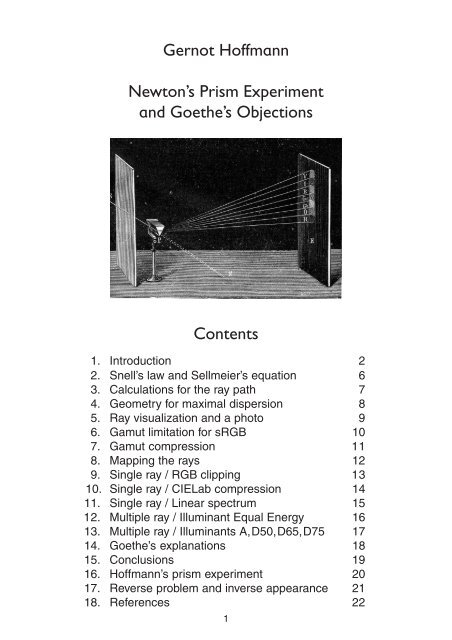
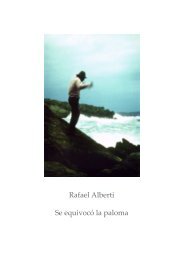
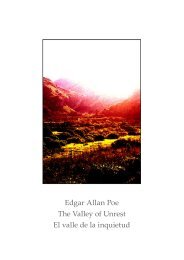

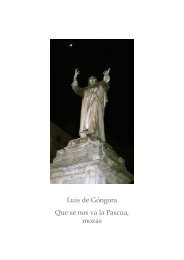
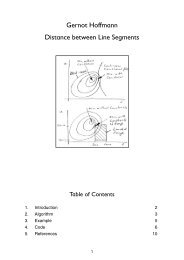
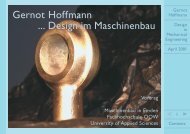
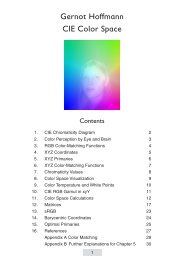
![[PDF] SpieleProgrammierung](https://img.yumpu.com/6860251/1/190x135/pdf-spieleprogrammierung.jpg?quality=85)
